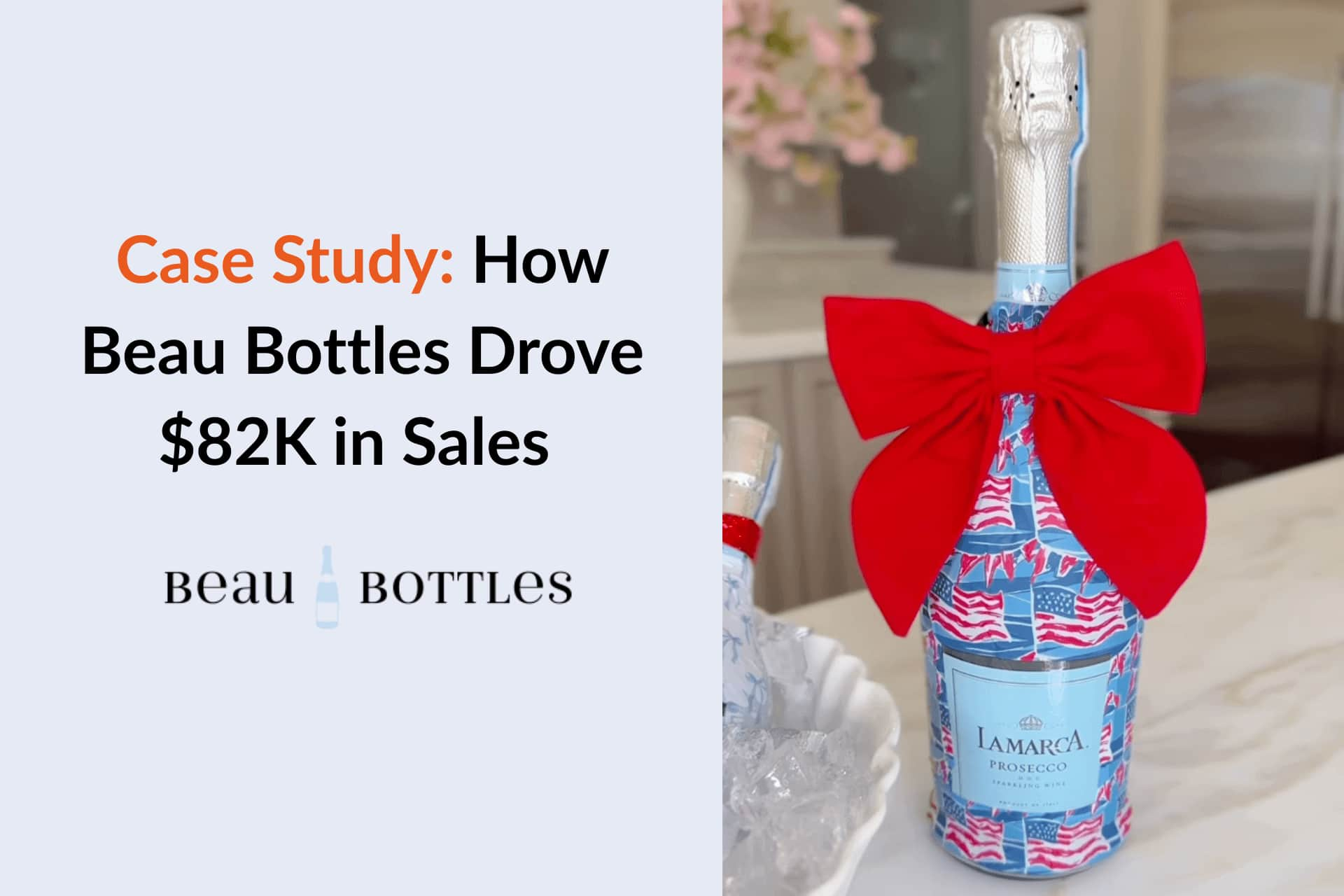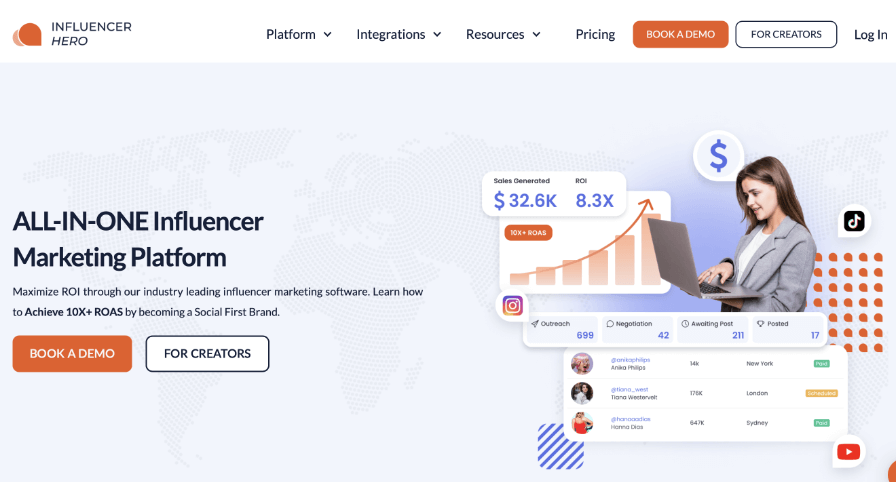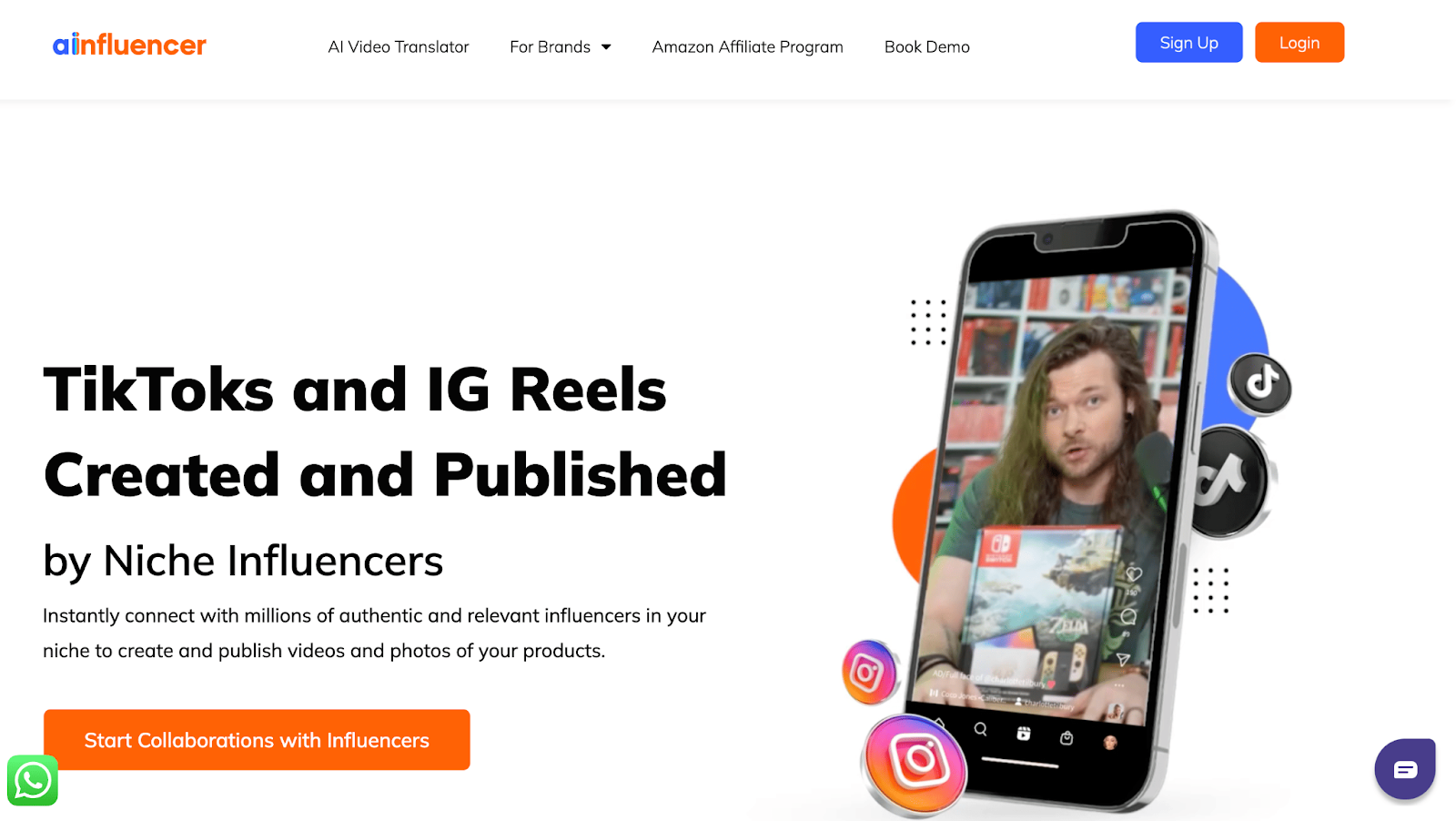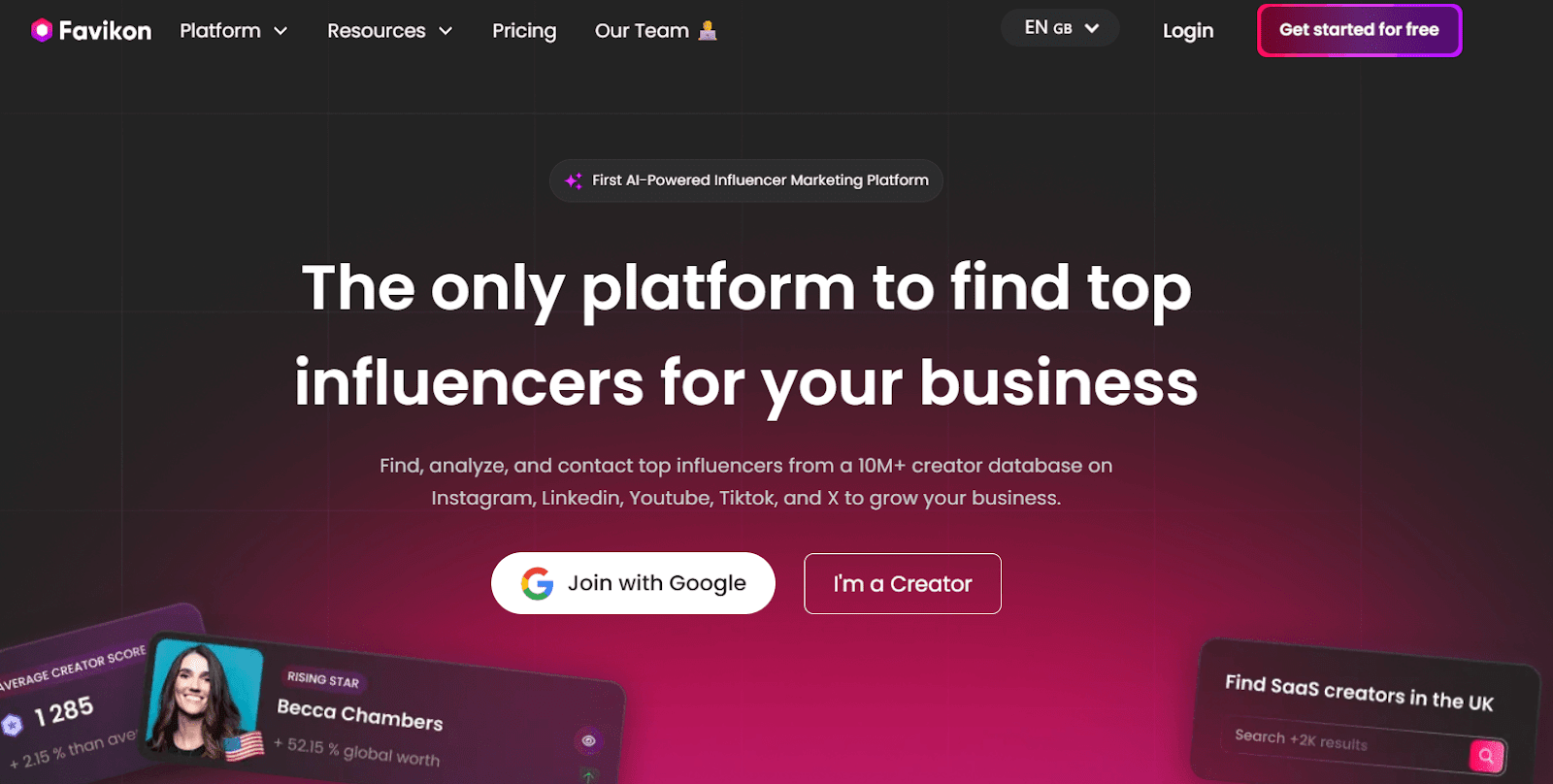





Influencer marketing platforms like MOGL have become popular for their focus on U.S.-based college athlete creators and performance-based payouts, with accessible starter plans and streamlined campaign management. However, some brands find MOGL’s niche focus and limited platform integrations restrictive, prompting a search for alternatives that offer broader influencer discovery, deeper analytics, and multi-platform support.
In this article, we’ll explore the top 10 MOGL alternatives, comparing their key features, pricing, advantages, and drawbacks to help you choose the best influencer marketing platform tailored to your brand’s goals and budget.
Top 10 MOGL Alternatives
While MOGL excels at connecting brands with U.S.-based college athlete influencers and offers performance-based payouts, there are several limitations that might lead brands to explore other options:
MOGL’s specialization in U.S. college athletes means its creator pool is relatively narrow, which may not suit brands seeking global reach or influencers across more diverse lifestyle or professional categories.
The platform primarily supports Instagram with limited TikTok functionality and lacks discovery tools for other major channels like YouTube, restricting campaign scope for brands wanting cross-platform presence.
MOGL doesn’t provide built-in gifting automation or affiliate tracking integrations, requiring brands to manage product seeding and commission tracking outside the platform or via additional tools.
While MOGL centralizes messaging and content approvals, it lacks more advanced workflow automation like automatic reminders or integrated performance tracking, which can slow down campaign management for larger teams.
Payments to influencers are limited to the U.S., making it difficult for brands targeting global creators or managing multi-region campaigns without manual payment arrangements.
To compare the different platforms, we focused on central criteria that all must meet:

Platform Coverage: Instagram and TikTok (with emphasis on student athlete creators)
Best For: U.S.-based brands targeting Gen Z audiences through college athlete influencers—especially in food, lifestyle, fitness, and home-related verticals. Ideal for teams looking to restart influencer campaigns with better structure and accountability.
Pricing:
Reviews: 4.0/5.0 (Capterra)
Ease of Use (UX/UI): MOGL is designed to simplify influencer collaborations through a centralized self-serve dashboard. Campaign creation, messaging, content approvals, and payouts are all managed in one place. Though the UX prioritizes function over flashy design, it's intuitive for teams managing multiple creators. The inbound application system streamlines outreach, and AI tools remove manual filtering.
Customer Support: Professional plan users get access to enhanced support, while Elite users are paired with a dedicated success manager. The platform also offers chat support at all tiers and manages campaign setup, content production, and Meta ad amplification for managed-service clients.

Platform Coverage: Influencer Hero supports influencer marketing across Instagram, TikTok, YouTube, Facebook, Pinterest, Snapchat, X (Twitter), and Twitch.
Best For: Influencer Hero is best for fast-scaling DTC brands and eCommerce businesses on Shopify, WooCommerce, or custom setups looking to run high-volume influencer, affiliate, and UGC campaigns from a single dashboard.
Pricing: Influencer Hero offers flexible monthly plans:
Reviews: 5.0 / 5.0 on Capterra
Ease of Use (UX/UI): Influencer Hero delivers a highly intuitive experience built for speed and efficiency. The interface features a clean layout, visual campaign pipelines, and smart prompts that guide users through discovery, outreach, and reporting. From real-time progress tracking to drag-and-drop tools, it’s especially efficient for small-to-mid-size teams scaling influencer campaigns fast.
Customer Support: Support is a key differentiator for Influencer Hero. Every customer is assigned a dedicated point of contact for strategy and onboarding. The platform also offers 24/7 live chat with real humans, a deep knowledge base, and responsive email support. Higher-tier customers enjoy direct access to a private Slack channel for real-time collaboration with the support team.
MOGL is built for brands targeting Gen Z through U.S.-based college athletes, offering AI-powered matching, inbound applications, and guaranteed content delivery after proof of post. Influencer Hero, on the other hand, supports broader use cases with creators across Instagram, TikTok, and YouTube—especially for lifestyle, food, wellness, and DTC brands.
While both platforms offer automated workflows, Influencer Hero stands out with deeper eCommerce integrations (Shopify, WooCommerce), customizable CRM tools, and Chrome extension support, as well as a larger and global influencer database.
Pricing-wise, MOGL is more accessible with a $0 Starter plan and $250/month Professional plan, while Influencer Hero starts at a higher $649/month with more comprehensive features and premium support. Influencer Hero is ideal for teams looking for a full-stack, cross-platform solution with advanced automation.

Platform coverage: Instagram, YouTube and TikTok. Limited functionality for influencers from Snapchat and X.
Pricing: Modash pricing starts at $199 per month. They also offer a medium tier plan fixed at a $499 rate. The enterprise level plan has custom pricing.
Reviews: 4.9/5.0 (Capterra)
Ease of Use (UX/UI): Modash is built for fast, data-driven influencer discovery with an interface that feels clean and purposefully minimal. Filters for engagement, audience demographics, and content relevance are easy to apply, but tapping into advanced analytics and campaign insights may require a short learning curve—especially for first-time users.
Customer Support: Support is primarily offered via chat and email, with a self-serve Help Center full of documentation and tutorials. Users on higher plans benefit from quicker response times and more strategic input, while those on lower tiers may experience slower turnaround or more generic replies.
MOGL is tailored for brands looking to reach Gen Z audiences through U.S.-based college athletes, with a strong emphasis on performance-based payouts and campaign automation. Modash, by contrast, is built for global scalability—offering access to over 350 million public profiles across TikTok, Instagram, and YouTube, making it ideal for teams running international, multi-platform campaigns.
When it comes to workflow, MOGL simplifies the process with inbound influencer applications, proof-of-post payout triggers, and built-in content usage rights. Modash leans into high-volume search and outreach, with bulk messaging, AI filters, real-time content tracking, and Shopify-integrated affiliate tools—but licensing and paid media need to be handled separately.
Pricing-wise, MOGL starts at $0/month (with a 50% service fee) and scales to $250/month with enhanced features. Modash’s entry-level plan begins at $199/month, while its mid-tier Performance plan is fixed at $499/month—making Modash better suited for brands with a larger budget and broader targeting goals.

Platform coverage: Upfluence covers Instagram, TikTok, YouTube, X, Twitch, Pinterest, and WordPress blogs.
Pricing:
Reviews: 4.6/5.0 (G2)
Best For: E-commerce brands and agencies looking to scale YouTube influencer outreach and track ROI.
Ease of Use (UX/UI): Upfluence offers a centralized dashboard where users can manage everything from creator discovery to campaign execution and sales tracking. While the layout is intuitive for standard workflows, teams handling larger or multi-market initiatives may need time to explore and fully utilize the platform's robust capabilities.
Customer Support: Support includes onboarding help, 1-on-1 sessions, and dedicated success managers for premium users. However, some brands report delays in communication or confusion around contract flexibility—especially regarding billing structure and platform commitments.
MOGL is geared toward brands targeting Gen Z through U.S.-based college athletes, offering AI-driven creator matching, proof-based payouts, and simple campaign execution with full content rights. Upfluence, on the other hand, caters to eCommerce-driven teams looking to run gifting or sales-focused campaigns across multiple platforms using their existing influencer contacts or new discovery.
While MOGL emphasizes speed, affordability, and accountability through inbound applications, Upfluence stands out with robust CRM features, competitor tracking, and deep integrations with Shopify and Amazon. However, Upfluence may require more onboarding time and is better suited for brands running large, ongoing campaigns.
Pricing is where these platforms diverge significantly. MOGL starts at $0/month (with a 50% fee) and scales to $250/month, while Upfluence’s standard plan begins at $1,276/month with a 12-month commitment—or $399/month for gifting-only campaigns—making MOGL more accessible for leaner teams or test-phase campaigns.

Platform coverage: Captiv8 covers Instagram, TikTok, Facebook, YouTube, X (formerly Twitter) and Twitch.
Pricing: $25.000 Annually (Annual commitment needed). Plus a $3.000 onboarding fee.
Reviews: 4.5/5.0 (G2)
Best for: Brands and agencies running large-scale influencer campaigns in platforms like Instagram, TikTok and YouTube.
Ease of Use: Captiv8’s platform is designed for seasoned marketing professionals, delivering sophisticated tools for influencer identification, campaign management, and detailed performance tracking. While the interface is well-organized and powerful, the sheer number of features may pose a learning curve for smaller teams or newcomers to influencer marketing software.
Customer Support: Users receive personalized onboarding, dedicated account managers, and routine campaign evaluations. However, some feedback highlights delays in response times and occasional inconsistencies in resolving issues, especially around billing and urgent campaign matters.
MOGL and Captiv8 serve different niches within influencer marketing, with MOGL specializing in U.S.-based college athlete creators mainly on Instagram and TikTok, while Captiv8 targets broader influencer campaigns with a focus on large-scale brand collaborations.
MOGL’s platform is streamlined for teams seeking straightforward campaign management with performance-based payouts and AI-driven creator scoring, whereas Captiv8 offers a more complex suite of advanced analytics and extensive social listening tools suited for experienced marketing teams.
When comparing pricing, MOGL offers a more accessible tiered structure starting at $0/month plus a 50% service fee, scaling up to a $250/month Professional plan with a 20% service fee, and custom pricing for Elite full-service support. In contrast, Captiv8’s pricing begins at approximately $25,000 annually, which may be cost-prohibitive for smaller brands but provides comprehensive agency-grade tools and collaboration features.

Platform Coverage: CreatorIQ supports Instagram, TikTok, YouTube, Facebook, Pinterest, Twitch, and X (Twitter).
Pricing: CreatorIQ pricing is divided into 4 tiers:
Reviews: 4.6/5.0 (G2)
Best For: Large-scale brands that require robust data controls, customizable workflows, and in-depth influencer analytics across international markets.
Ease of Use (UX/UI): CreatorIQ delivers a sleek, intuitive dashboard that merges influencer discovery, campaign oversight, and analytics into a cohesive platform. Its clean design supports seamless navigation, making it well-suited for teams managing extensive influencer programs.
Customer Support: Clients benefit from dedicated account managers and customer success teams offering onboarding, campaign support, and regular performance reviews. Strategic consultants provide expert guidance to help brands refine and maximize their influencer marketing strategies beyond basic platform use.
MOGL and CreatorIQ cater to very different influencer marketing needs, with MOGL focusing on U.S.-based college athlete creators and streamlined campaign management, while CreatorIQ serves large enterprises managing high-volume, complex influencer programs across multiple platforms.
MOGL’s platform emphasizes ease of use with AI-powered matching and performance-based payouts, making it ideal for brands targeting Gen Z athletes. In contrast, CreatorIQ offers a polished, enterprise-grade solution with advanced API data integrations, scalable outreach, and deep analytics trusted by global brands like Disney and Unilever.
When it comes to pricing, MOGL offers a tiered structure accessible to smaller teams, starting from a free plan with a 50% service fee and scaling up to $250/month plus a 20% service fee for professional users, with custom pricing for full-service Elite plans. CreatorIQ’s pricing is significantly higher, with annual plans beginning at $35,000 for basic access and going up to $200,000 for enterprise customers, reflecting its focus on large-scale, data-intensive influencer marketing operations.

Platform Coverage: HypeAuditor supports Instagram, TikTok, YouTube, Twitch, X (Twitter), and Snapchat.
Pricing: Flexible usage-based pricing, with Business plans starting at around $10,000/year and Enterprise reaching up to $60,000/year.
Reviews: 4.6/5.0 (G2)
Best For: Teams that prioritize data accuracy, detecting fraudulent activity, and benchmarking competitors across various influencer platforms.
Ease of Use (UX/UI): HypeAuditor offers a streamlined, user-friendly interface that makes influencer discovery and basic campaign setup straightforward. However, exploring its advanced AI features and detailed filtering options may require some acclimation, especially for users new to influencer marketing tools.
Customer Support: Users have access to live chat and email assistance, complemented by a comprehensive onboarding process designed to help launch campaigns effectively. The platform’s Help Center provides extensive resources, including video tutorials, strategic guides, and FAQs for ongoing independent support.
MOGL and HypeAuditor serve distinct influencer marketing needs, with MOGL focusing on U.S.-based college athlete creators and streamlined campaign management, while HypeAuditor offers a data-driven platform with a vast influencer database and AI-powered discovery tools suited for broader influencer campaigns.
MOGL’s interface is designed for simplicity and accountability through performance-based payouts and inbound applications, whereas HypeAuditor excels in advanced analytics, brand monitoring, and flexible campaign customization.
In terms of pricing, MOGL provides a tiered and accessible structure starting from a free plan with a 50% service fee, scaling up to $250/month plus a 20% service fee for professional users, making it ideal for smaller teams and niche campaigns.
HypeAuditor’s pricing is significantly higher, with Business plans starting around $10,000 per year and Enterprise packages reaching $60,000 annually, reflecting its emphasis on comprehensive data and advanced AI capabilities for larger brands.

Platform Coverage: Instagram, TikTok, YouTube, X (formerly Twitter), Twitch, and Snapchat.
Pricing: GRIN’s yearly pricing starts at $25.000, with monthly payments available at $2.085/month. No discounts for upfront payments.
Best For: Best suited for DTC brands looking to centralize influencer relationship management in one streamlined system.
Reviews: 4.5/5.0 (G2)
Ease of Use (UX/UI): GRIN is designed for internal marketing teams, featuring a sleek and intuitive interface that consolidates all influencer marketing tasks. Its built-in integrations with platforms like Shopify simplify managing gifting, affiliate tracking, and campaign workflows, even for users with limited technical skills.
Customer Support: The platform provides structured onboarding, a detailed help center, and generally responsive customer service. However, some users report occasional delays in resolving technical glitches or billing inquiries, which can impact campaign timelines.
MOGL and GRIN target different segments within influencer marketing, with MOGL specializing in U.S.-based college athlete creators and streamlined campaign management, while GRIN offers a robust all-in-one platform designed for in-house marketing teams managing broader influencer programs.
MOGL’s platform emphasizes simplicity, AI-powered creator matching, and performance-based payouts, whereas GRIN focuses on deep eCommerce integrations, full-funnel campaign management, and automation for gifting, outreach, and payments.
In terms of pricing, MOGL provides a flexible tiered structure starting with a free plan plus service fees, scaling up to $250/month plus a 20% service fee for professional users, making it accessible for smaller or niche campaigns. GRIN’s pricing is significantly higher, with plans starting at about $2,085 per month or $25,000 annually, reflecting its enterprise-level features and extensive integrations suited for larger marketing teams.

Platform Coverage: Instagram, TikTok, and YouTube.
Best For: Brands looking for a self-serve, no-cost influencer platform—or those needing full campaign support without committing to a monthly software subscription.
Pricing: Ainfluencer is free to use for self-managed campaigns (minimum influencer payment: $10). For full-service management, they offer fixed-price packages:
Review: 4.8 / 5.0 (G2)
Ease of Use (UX/UI): Ainfluencer offers a simple and approachable interface designed for beginners, making campaign setup and influencer communications easy. Payments are securely processed through an integrated escrow system and credit card checkout, though the platform requires manual follow-up for post-campaign deliverables and compliance tracking.
Customer Support: Support responsiveness is generally good but can vary, with some users reporting delays. While the escrow protects payments until deliverables are approved, refund processes may take several days and need administrative clearance, and occasional delays have been noted in resolving influencer performance concerns.
Ainfluencer’s Standout Features
MOGL and Ainfluencer offer distinct approaches to influencer marketing, with MOGL specializing in U.S.-based college athlete creators and streamlined, performance-based campaigns, while Ainfluencer provides a beginner-friendly platform focused on Instagram and TikTok creators with an escrow payment system.
MOGL’s AI-driven creator matching and inbound application process make it ideal for brands targeting Gen Z athletes, whereas Ainfluencer’s simple interface and AI-assisted outreach suit smaller teams or those new to influencer marketing.
In terms of pricing, MOGL offers a tiered structure starting with a free plan plus service fees and scales to $250/month plus a 20% service fee, making it accessible for smaller or niche campaigns. Ainfluencer is free for brands running self-managed campaigns, with a minimum influencer payment of $10, but full-service campaign packages range from $7,999 to $29,999 depending on the campaign length and scale.

Platform Coverage: Instagram, TikTok, YouTube, and X (Twitter – analytics only).
Best For: Brands that want broad influencer access, integrated Shopify gifting, and Kanban-style campaign tracking.
Pricing:
Reviews: 4.3 / 5.0 (G2)
Ease of Use (UX/UI): Influencity features a sleek, modular dashboard that enables brands to customize workflows for influencer search, campaign execution, and performance tracking. Despite its rich functionality, the platform remains organized and user-friendly, supported by guided onboarding to help teams manage complex data-driven campaigns.
Customer Support: The platform offers responsive live chat and email support, along with an extensive help center and onboarding materials. While most users praise the timely assistance, more technical or intricate inquiries occasionally require longer resolution times.
MOGL and Influencity serve different influencer marketing needs, with MOGL focusing on U.S.-based college athlete creators and streamlined campaign management, while Influencity offers a broad influencer database and advanced AI-powered discovery tools suitable for brands running larger, data-driven campaigns.
MOGL’s platform emphasizes ease of use, performance-based payouts, and a niche focus on Gen Z athletes, whereas Influencity provides extensive creator access, visual campaign boards, and Shopify integration for affiliate and gifting management.
When it comes to pricing, MOGL offers a flexible tiered structure starting from a free plan plus service fees and scaling to $250/month plus a 20% service fee, making it accessible for smaller teams or niche campaigns.
Influencity’s plans start at $318/month for professional use and go up to $798/month for business users, with custom pricing for enterprise clients; the auto-tracker feature is an additional $660 per year, reflecting its focus on scalable and data-intensive influencer marketing efforts.

Platform Coverage: Instagram, TikTok, LinkedIn, YouTube, and X (formerly Twitter).
Best For: Teams and solopreneurs focused on influencer discovery and vetting, especially those who prioritize analytics over full campaign execution.
Pricing: Favikon has the following plans:
Review: 4.6 / 5.0 (G2)
Ease of Use (UX/UI): Favikon is known for its simple, user-friendly interface that emphasizes clarity and visual insights. The platform caters to marketers focused on influencer evaluation and benchmarking, featuring a straightforward dashboard with accessible analytics and quick search capabilities to aid fast decision-making.
Customer Support: Favikon provides in-app chat and email assistance, which users generally find prompt and helpful. However, those requiring advanced support for complex integrations or tailored workflows may encounter limitations in available support options.
MOGL and Favikon cater to different influencer marketing needs, with MOGL specializing in U.S.-based college athlete creators and performance-based campaign management, while Favikon focuses on influencer scoring, audience analysis, and relationship management for a broad range of creators.
MOGL’s platform is tailored for teams seeking simplicity and accountability through AI matching and inbound applications, whereas Favikon offers detailed influencer evaluation with AI-powered scoring and deep audience insights.
Regarding pricing, MOGL provides a tiered structure starting from a free plan plus service fees up to $250/month plus a 20% service fee, making it accessible for smaller or niche campaigns. Favikon’s pricing starts at $69 per month for the Starter plan, scaling up to $299 per month for the Pro plan with unlimited creator discovery and advanced analytics, appealing to brands that prioritize detailed influencer assessment and CRM capabilities.
MOGL is a strong platform for brands targeting U.S.-based college athletes and managing performance-driven campaigns, but it may fall short for teams needing expansive influencer discovery, in-depth analytics, and seamless multi-platform campaign execution. While MOGL excels in accountability and niche focus, its scope is narrower compared to other influencer marketing solutions that cater to broader audience segments and offer richer data insights.
The alternatives featured in this article provide more versatile and scalable tools suited to today’s complex influencer marketing landscape. Influencer Hero stands out as a leading choice, offering a comprehensive all-in-one platform that combines powerful discovery, automated outreach, streamlined campaign management, and robust analytics.

MOGL is ideal for brands targeting U.S.-based college athlete influencers, especially in lifestyle, fitness, and food verticals. It excels in managing performance-based campaigns with streamlined workflows and accountability through proof-of-post payments.
Although MOGL specializes in a unique niche with easy campaign management, it has limited scope regarding global influencer pools, platform integrations, and advanced analytics. Brands looking for broader influencer discovery, multi-platform support, and deeper data insights may find better options with alternatives like Influencer Hero or Influencity.
Top alternatives include Influencer Hero, Influencity, GRIN, and HypeAuditor. These platforms offer extensive influencer databases, AI-powered discovery, automated outreach, and comprehensive campaign analytics. Influencer Hero is particularly notable for its all-in-one toolkit, combining ease of use, powerful features, and scalable pricing.
MOGL’s tiered pricing starts with a free plan plus service fees and scales up to $250/month plus a 20% service fee, making it affordable for niche campaigns. In contrast, platforms like Influencer Hero provide flexible pricing options tailored to brand size and needs, while others like Ainfluencer and Favikon offer free or budget-friendly alternatives suited for smaller teams.
Influencer Hero stands out as an excellent choice for startups and smaller brands due to its intuitive interface, automation capabilities, and flexible pricing. Ainfluencer is also appealing for those on a tight budget, offering a free self-service model with optional full-service packages.



Schedule a Demo with one of our media experts below.